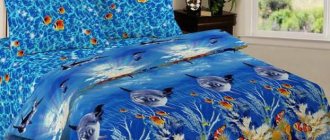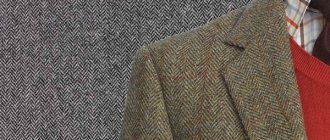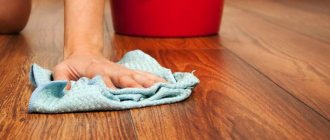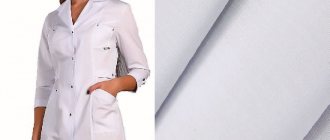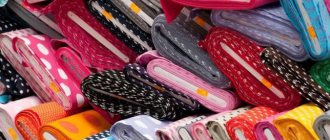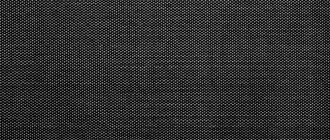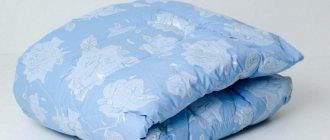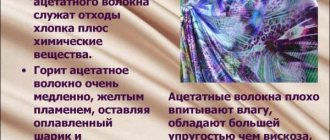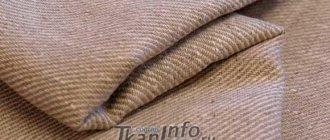Concern about choosing a school uniform and the problems of caring for it are well known to every family in which children are growing up.
School suits, skirts, sundresses, blouses and shirts are worn constantly and are subject to intense stress, especially among active children. This expense item makes up a significant part of the home budget, and they largely depend on how long school things will remain in decent appearance.
Types of materials
In many ways, a child’s desire to attend an educational institution depends on what fabric parents choose for sewing a school uniform. A children's suit should not only be comfortable, but also beautiful. Most often, natural fabrics with high quality indicators are used:
- velveteen;
- twill;
- wool;
- cotton;
- batiste;
- cotton jersey with a small addition of viscose.
Wool and cotton fabrics
Wool and cotton are hygroscopic and meet all the requirements of Rospotrebnadzor. However, they have many disadvantages. First of all, it is high price and impractical. Cotton stretches quickly and shrinks after the first wash, but wool will have to be dry cleaned. Ironing such materials also causes a lot of trouble and requires a special approach.
Wool is a type of suit fabric. You should not buy completely natural material; it should contain 5% lycra or viscose to ensure strength. For sewing uniforms, the percentage of synthetics in the fabric composition can vary from 40 to 60%. This composition makes the products practical, protects them from deformation, and also allows you to achieve a complete fit without restricting movement. To sew a suit for a schoolchild, you can choose several variations of the material:
- Gabardine is a dense material, with a small rib, which practically does not wrinkle.
- Pikachu - perfect for sewing tight-fitting suits, thanks to the diagonal weave of threads with the addition of elastane.
- Tartan tartan is a natural fabric with the addition of synthetics.
Synthetics
It is not recommended to use artificial fabrics for the manufacture of children's trousers and especially shirts. For example, polyester and elastane have excellent stretch and allow you to create many models that will fit exactly to your figure, will not hinder movement, but can cause irritation to the skin. In addition, synthetics do not allow air to pass through well, so the child will constantly sweat.
All the best for children: requirements for materials
Students spend a lot of time in lessons - 5-6 or more hours. Therefore, the most stringent requirements are imposed on the fabrics from which school uniforms are made:
- Air permeability: materials must allow air to pass through. If there is a lot of synthetics in the composition, then the clothes interfere with normal ventilation and create a greenhouse effect.
- Hygroscopicity: fibers must absorb and remove moisture from the body. The required level of water absorption is not less than 10%.
- Antistatic: if clothes become electrified, they strongly stick to the body, causing discomfort. The child becomes distracted, irritable, and learns the lesson worse. Therefore, the best material for school uniforms is a natural or mixed composition with a low degree of electrification.
- Hypoallergenic: the fabric for the school uniform should not contain toxic substances that can cause skin irritation and breathing problems;
- Strength, elasticity: clothing should not hamper or restrict movement, tear or stretch.
- Restrained color scheme: shades do not irritate or distract attention:
- Easy to care for: Student clothes need to be washed frequently, so the fabrics need to be practical.
Important! The main task of a school uniform is to create a healthy microclimate under clothing and ensure the safety of the child’s health.
What to look for when choosing suits
Back in the USSR, a common school uniform was introduced for students, which met all quality standards. Today, unfortunately, not every manufacturer strives to sell “safe” children's clothing. Rospotrebnadzor calls on all residents of Russia to pay special attention to fabric composition. Any store must have quality certificates. Don’t be afraid to demand them, because your child’s health depends on it.
The uniform should not restrict movement, because the child will spend about 8 hours a day in it:
- the jacket must be selected according to the size of the shoulders;
- trousers should not be too tight around the hips;
- if you need a tie, then for kids it is better to choose models with an elastic band, they are more practical;
- The correct choice of fabric for a school uniform will make it easier to care for and increase their wear resistance.
Many parents are simply outraged by the current quality of children's clothing. The high content of synthetic fibers in the materials leads to overheating in summer and freezing in winter. Children often complain of itching and headaches. The first sign of low-quality material is a sharp, unpleasant smell of rubber.
The color scheme of the uniform is approved by the school council, so it will be different for each educational institution. It is better to sew clothes for a schoolchild yourself than to spend a large amount of money on a uniform of dubious quality. The following video will tell you how things are with the purchase of school uniforms in Russia and their quality.
What should the form be?
The requirements for children's clothing can be divided into several areas:
- Hygiene. The material for children's clothing should provide air circulation, thermoregulation, absorb sweat, not irritate the skin and be comfortable to the touch.
- Strength and elasticity. Children move actively, so for school clothes you should choose fabric with sufficient elasticity that provides freedom of movement and is resistant to wear, tearing, and thread tightening. However, since schoolchildren spend a lot of time sitting, their clothes should not stretch or deform, which is especially important for school trousers and jackets.
- Easy to care for. Children's clothes get dirty easily, so they should be easy to clean and, if possible, washable, wrinkle little and be ironed quickly.
The range of “school” fabrics is quite large and is replenished every season. Manufacturers often give different names to similar materials, and understanding them is not so easy.
When purchasing uniforms for your child, you should definitely ask what raw materials they are made from and whether they have the appropriate certificate.
This is especially true for products that are in direct contact with the body (shirts, blouses, etc.). For suits and sundresses, be sure to check their tightness (against light) and ask for the care instructions on the sewn-on label.
How to check the integrity of the manufacturer
There are several rules based on which you can protect yourself when purchasing:
- Conscientious manufacturers sew the label into the seam of the product itself. Otherwise, you should refuse the purchase.
- In addition to the composition of the fabrics and care recommendations, the label must contain the manufacturer’s contact information.
- The label must indicate mode II of wet-heat treatment. This will confirm the naturalness of the fabrics.
- The inner lining of suits is made only of viscose.
What is biofluff?
Artificial down, bio-down, is a synthetic analogue of swan down. Why did scientists decide to recreate it? Everything is simple here: swan down is the best filler for blankets and pillows, as well as insulation for winter down jackets, jackets, and overalls. It perfectly insulates the body even from the most severe frosts. Its biggest disadvantage is the high price; yes, it is expensive material. The second disadvantage of the product is the need to create special conditions for washing products filled with natural swan down.
The first to develop synthetic bio-down in the 70s were specialists from 3M Thinsulate and DuPont. As a basis for artificial bio-down, they took a biopolymer with the renewal of its constituent components. People learned later what biofluff in the broad sense of the word is and found a use for it. The main purpose is eco-down as a filler. With its advent, the industry found a light and cheap filler that is as close in its properties to natural fluff as possible.
Properties, advantages and disadvantages of eco-down
Bio-down is an environmentally friendly material. This is one of the first bio-based fillers. It will freely protect from frost down to minus 35-40 degrees. It has a spherical three-dimensional structure. The prototype of the structure for the developers was natural swan fluff. The composition of eco-down determined the advantages of this material as a filler for outerwear and home textiles. Currently, this is one of the cutting-edge fillings for down jackets.
Advantages of artificial swan down
- Bio-fluff does not roll off or form into clumps.
- It has a wide range of uses: it is used to fill home textiles and outerwear.
- Eco-down does not absorb moisture, it is moisture resistant.
- It has light weight and high thermal insulation properties; artificial swan down retains heat in jackets and down jackets, where it is used for insulation.
- Does not cause allergies, eco-down is hypoallergenic. This is a completely environmentally friendly and safe material.
- It has high biostability, which means that it does not rot, does not decompose, and fungi and bacteria, mites and moths do not multiply in it.
- Bio-fluff does not absorb odors, it is interspersed.
- Bio-down fibers do not come out through seams and fabric.
- Quickly restores its original volume after creasing and washing.
- Provides effective heat conservation and protection from frost down to minus 40.
- It is a durable material.
- Does not deform and does not lose volume, thickness and shape during the entire period of use of the product.
- Bio-lint can be washed many times. It is machine washable. It dries quickly, literally in a few hours, does not pill and quickly returns volume.
- It does not require special operating conditions and is easy to maintain.
Disadvantages of bio-fluff
Bio-down filler has few disadvantages. These include the ability of a material to accumulate static stress. Also, artificial swan eco-down is afraid of open fire, it is not resistant to high temperatures, and also removes water from the body for a long time.
What artificial insulation materials are similar in their properties to natural down?
The list of analogues includes the most modern fillings for jackets, overalls and down jackets:
- ecofiber (holofiber)
- nanometer – artificial swan down;
- bio-down - synthetic down;
- synthetic fluff;
- Thinsulate.
Where is eco-down used?
They use nanometer, bio-down or eco-down in outerwear for women, men and children. They put bio-down in coats, jackets, raincoats, children's overalls, and ski suits. Artificial swan down is also a popular filler for winter sports equipment; it is used to insulate winter sports suits, ski suits, and clothing for snowboarders.
Bio-down is used for outerwear of fishermen, hunters, and tourists. Sleeping bags are also stuffed with eco-down. Any down jacket, coat, overalls or jacket made from biodown does not become thinner during wear; it protects well from low temperatures for several seasons.
Bio-fluff in outerwear reviews
Unlike natural, artificial swan down has more positive reviews. Everyone who wore a down jacket filled with a swan down analogue loudly claims that it was warm even at minus 40 degrees Celsius.
As for washing, there were no problems here either. It was enough to put the jacket in an automatic washing machine and spin it at 30 degrees. After washing, the clothes had their original fresh appearance. The price of artificial swan down filling is several times lower than that of its natural progenitor. This means that things have become more affordable without compromising the quality of the product.
People suffering from allergies have a special relationship with the artificial swan bio-down filler. Products using this material have become absolutely safe for them; they do not cause negative reactions or skin irritation. Artificial swan down is also called nanometer; it is an almost weightless, comfortable material that holds volume well.
Reviews of bio-down as a filler for outerwear say that it is much warmer than synthetic padding, safer than wool and natural down, and lighter than holofiber. They also often ask: what is warmer, artificial bio-down or Thinsulate?
What is warmer: bio-down or Thinsulate?
If we consider the heat capacity of the material, a jacket with Thinsulate filling will protect against frost of minus 25-30 degrees. Although, this depends on the thickness of the insulation. A down jacket with bio-down insulation (artificial swan down) will keep you warm even at minus 35-40 degrees. You can find out which filler is better and study their comparative characteristics in this article.
Do you still have questions? Have you found out what biofluff is? What are its properties? What is eco-down and how does artificial swan down differ from natural one?
Do you have outerwear filled with artificial swan down? What is your opinion about this insulation? Share your reviews in the comments! Let's talk about bio-fluff!
Street style, what is fashionable to wear in spring 2021: TOP 8, photos
TOP 10 FASHION TRENDS OF SPRING/SUMMER 2021 FASHION WEEK
Who suits red hair color
9 cool life hacks that will help you maintain the color of your dyed hair
What hair color is in fashion? 10 color trends of the year
Five ways to wear a slip dress in winter
How to choose and buy a new bag
Bags 2021: fashion trends
Tartan fabric
Tartan is a checkered fabric that everyone invariably associates with the men's national clothing of the Highlanders of Scotland. More correctly, this checkered fabric should be called tartan. Classic tartan is created by weaving cotton and wool threads.
Historical reference
Why we call this material tartan is obvious, but why it is called tartan is difficult to say. This is because there is controversy regarding the history of this nomination. According to some etymological speculations, the pedigree of the lexeme “tartan” goes back to the French tiretaine, meaning coarse woolen fabric. There is another theory. It is believed that the word goes back to the ancient Gaelic dialectic tarsainn, which translated means crosswise or across.
Manufacturing
Scottish plaid is created from woolen threads woven crosswise. These threads are pre-dyed in the desired color. The wool thread is first threaded under two cotton threads, then over two of the same. This simple technology allows you to make a cell.
In ancient times, the Scots had many variations of cells, but no one kept a record of these variations on the theme. So, in the historical and cultural aspect of national vestments, the Scots lost a little. Well, when they realized it, they ended up with two registers of real Scottish plaid: the Scottish Scottish Register of Tartans and the Scottish Tartans World Register. Currently, the national register contains over 6,000 combinations. As for the world register, there is a more meager variety - 3300. By the way, these days masters practice to their hearts' content and more and more new variations on the "tartan check" theme are born.
Nowadays, Scottish plaid is depicted not only on natural fabrics with a wool-cotton composition, but also on artificial materials and synthetics. (You can go to the Rosa Maria website for examples.) For example, on polyviscose fabric for a suit.
Tartan fabric. Cloth
Scottish plaid is popular in any type of clothing: dresses, skirts, trousers, scarves. Children, teenagers and adults alike love tartan. It has no age or gender connection, and this state of affairs does not infringe on anyone. Why does everyone like her so much?
- Aesthetically. If someone doesn't like red, he will choose blue check. Haters of blue will choose green, etc. There are a lot of options for execution. Both the colors of the base and the cells. Everyone is happy with the checkered tartan fabric, with rare exceptions.
- Practical. On motley tartan fabric, stains or other “little disasters” are not so noticeable.
- Pairs perfectly with plain clothing.
